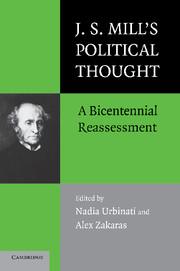Book contents
- Frontmatter
- Contents
- List of Contributors
- Introduction
- PART ONE LIBERTY AND ITS LIMITS
- PART TWO DEMOCRACY AND THE INDIVIDUAL
- PART THREE BEYOND NATIONAL BORDERS
- 11 Cosmopolitan Patriotism in J. S. Mill's Political Thought and Activism
- 12 Mill and the Imperial Predicament
- 13 Making Sense of Liberal Imperialism
- 14 Mill's “A Few Words on Non-Intervention”: A Commentary
- Bibliography
- Index
14 - Mill's “A Few Words on Non-Intervention”: A Commentary
Published online by Cambridge University Press: 08 January 2010
- Frontmatter
- Contents
- List of Contributors
- Introduction
- PART ONE LIBERTY AND ITS LIMITS
- PART TWO DEMOCRACY AND THE INDIVIDUAL
- PART THREE BEYOND NATIONAL BORDERS
- 11 Cosmopolitan Patriotism in J. S. Mill's Political Thought and Activism
- 12 Mill and the Imperial Predicament
- 13 Making Sense of Liberal Imperialism
- 14 Mill's “A Few Words on Non-Intervention”: A Commentary
- Bibliography
- Index
Summary
Mill's “few words” actually make up a longish essay, which I shall reduce to a few paragraphs, for the purposes of commentary. I want to isolate the key arguments and consider whether they still make sense. They made a lot of sense in the 1960s, when Americans were arguing about the Vietnam War and when many liberal and leftist intellectuals first started thinking and writing about the question of military intervention. The Millian claim that Vietnamese freedom depended on the Vietnamese themselves – on how much they valued freedom and on what sacrifices they were prepared to make for its sake – was repeated by just about every American political and military leader, but it was the opponents of the war who took it most seriously. Mill's essay was a favorite text of the antiwar movement. But there was never a simple right–left disagreement on intervention. Depending on the local circumstances, each side has been ready to send troops into someone else's country, and each side has criticized the government that sent (or didn't send) them in. The right wanted to roll back Soviet tyranny in Europe; many leftists would probably have supported a military intervention to end apartheid in South Africa. Neither right nor left has been entirely consistent, and both have divided in unpredictable ways. Perhaps another look at Mill's categories and criteria might help us all maintain a steady course.
- Type
- Chapter
- Information
- J.S. Mill's Political ThoughtA Bicentennial Reassessment, pp. 347 - 356Publisher: Cambridge University PressPrint publication year: 2007
- 4
- Cited by



